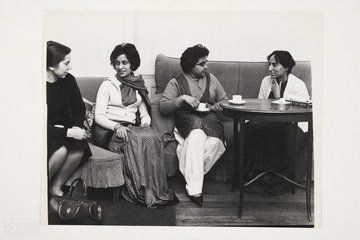
Community and Belonging
South Asians in Britain have forged community relationships in varying, interconnected ways, from establishing sports associations, social clubs and religious centres to hosting cultural events
Overview
South Asians in Britain have created community networks and connections in varying ways. In the nineteenth century, organizations like the National Indian Association and East India Association were places for middle- and upper-class Indians to meet British people. For seamen, pedlars and other working-class Indians, the need for education and welfare provision necessitated the establishment of social centres such as the Hindustani Social Club in Poplar, London in 1934. Meanwhile, Indian students formed connections in societies and hostels such as Student Movement House and the Indian Students’ Union, set up in 1920. By 1910, the Central Islamic Society in London – formerly known as Anjuman-i-Islam, which was established in 1886 – stated that its aims included advancing the needs of Muslims in Britain. These centres became critical sites of political mobilization against British colonial rule. In Londonderry, Northern Ireland, where multigenerational Indian families settled from the 1930s onwards, a house at 4 Simpson’s Brae, which was first purchased by pedlar Mohabat Vij in 1946, became an important place for Londonderry’s Indians to meet.
As South Asian populations grew after the Second World War, community centres and welfare provision became increasingly necessary across the UK. In 1963 the Labour government launched the Community Development Project, a Home Office-funded anti-poverty initiative which operated in twelve areas across the UK, including places with growing South Asian populations such as Oldham, where the project employed an Asian Liaison Officer who ran English education classes. In 1977 community organizer Ranjit Sondhi became the founding director of the Asian Resource Centre in Handsworth, Birmingham, which offered services such as housing and immigration support, as well as activities such as yoga. Similarly, in Glasgow, businessman, community leader and co-founder of the Glasgow Mela Sewa Singh Kohli founded Mel Milaap in 1989 for elderly South Asians. In Leicester the Belgrave Neighbourhood Centre, which was established in 1977, played a critical role in developing Leicester's Diwali celebrations, which are the largest outside India.
Safe spaces of belonging were critical for LGBTQIA+ South Asians across Britain, particularly considering the global pandemic of HIV/AIDS which began in 1981 and discriminatory legislation such as Section 28 of the Local Government Act 1988. The Black Lesbian and Gay Centre in London, which was formally established in 1985, held events such as weekly support groups, art shows and Q&As on topics such as health and housing for racialized minority LGBTQIA+ communities. In 1988 artist Poulomi Desai co-founded Shakti, the UK’s first South Asian LGBTQIA+ campaign group, which operated local branches in places such as Leicester, Bradford and Manchester. Shakti held regular events such as HIV/AIDS support meetings and arts programmes, as well as Shakti Disco, which was organized by DJ Ritu. In 2021 Vinay Jobanputra founded Bollyqueer, a LGBTQIA+ affirming Bollywood dance space that centres Queer and Trans people.
Another interesting thing
Sports has long facilitated community networking among South Asians in Britain. In 1889, as a student at Trinity College, University of Cambridge, the cricketer Kumar Shri Ranjitsinhji, Prince of Nawanagar, played for local Cambridge clubs. In 1916 the Indian Gymkhana Club was founded in Mill Hill, London and created space for Indian maharajas, such as Iftikhar Ali Khan, to play sports. The Hindustan Community House in London, which was founded by Kundan Lal Jalie in 1937, became an important social centre where working-class Indians could access sports. More recently, football referee Rosheen Khan leads a female-only football team in Grangetown, Cardiff to encourage women from minoritized communities to become involved in sport.
Browse this theme
Image credit
Four individuals sat down on sofas, by Henry Grant, HG2210/8.1, © Henry Grant Collection/London Museum, https://creativecommons.org/licenses/by-nc/4.0/
